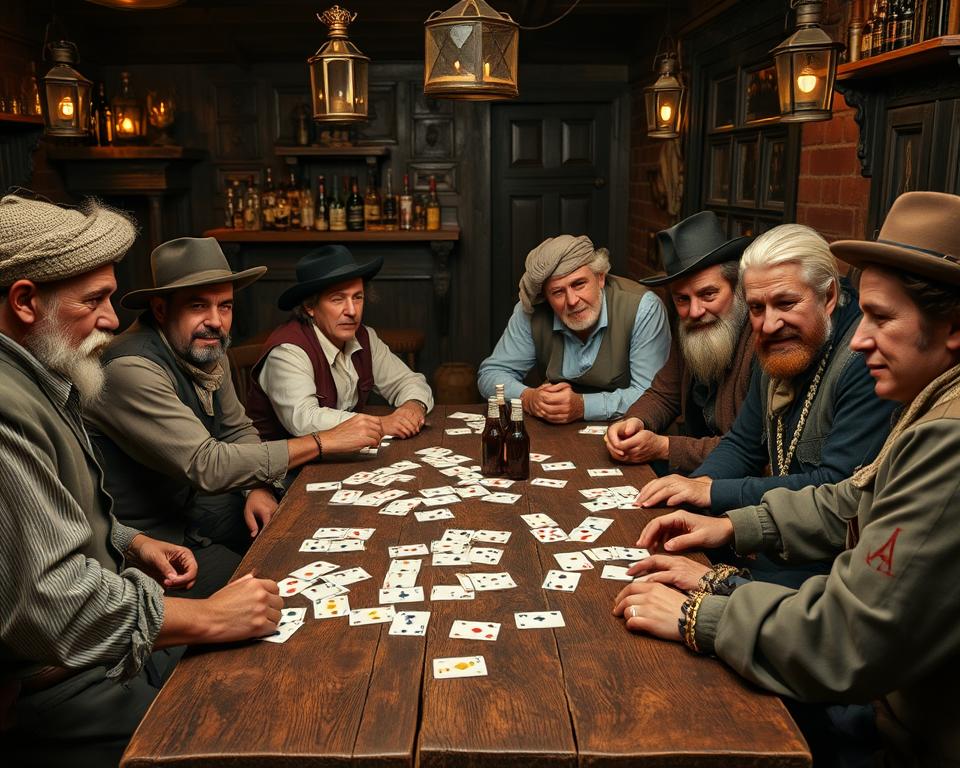
Poker has been a favorite game for centuries. It’s perfect for both beginners and those wanting to improve. This guide will give you the basics to start your poker adventure. You’ll learn about the rules, hand rankings, and strategies for popular variants like Texas Hold’em.
This article will take you through poker’s history, its rules, and hand rankings. We’ll also cover gameplay, bankroll management, and poker etiquette. Plus, we’ll explore online poker and tournaments. By the end, you’ll be ready to play poker with confidence.
Let’s get started and uncover poker’s secrets. Prepare for the excitement of the cards, the challenge of beating your opponents, and the joy of mastering poker.
Introduction to Poker
Poker is a captivating card game that has been loved by players around the world for centuries. It started with earlier games like As-Nas in Persia and Poque in France. The modern poker we know today began in the early 1800s in the United States. It has since become a favorite activity for people from all backgrounds.
What is Poker?
Poker is a game of skill, strategy, and luck. Players bet on the value of their cards. The goal is to make the best poker hand by using your cards and the community cards on the table. The player with the highest hand wins the pot.
History of Poker
The early history of poker dates back to the 1700s, from various card games in Europe and Asia. The modern version started in the United States in the early 1800s. It quickly became popular among riverboat gamblers and those in the Wild West.
“Poker is a game of people as much as it is a game of cards.”
Over time, poker has seen many changes and new versions. These changes came from different regions and cultures. From the classic Five-Card Draw to the popular Texas Hold’em, poker has kept players interested and engaged.

Whether you’re experienced or new to poker basics, knowing the game’s poker origins and history of poker is helpful. It gives you a deeper understanding of this timeless card game.
Poker Basics
Poker is a game that mixes strategy, luck, and competition excitement. The main goal is to make the best five-card hand from your cards and the community cards. Players bet to win the pot or make others fold.
The poker fundamentals teach about winning hands like the Royal Flush and Pair. To play well, you need to know your hand’s strength, understand your opponents, and decide when to bet or fold.
To play poker, you get hole cards only you see and community cards everyone shares. The aim is to make the best five-card hand. Betting rounds happen, giving you chances to improve your hand as more cards are shown.
- Learn the poker hand rankings from highest to lowest.
- Know how to read your cards and the community cards to figure out your hand’s strength.
- Get good at guessing what your opponents might do and make smart betting choices.
“Poker is not about who has the better cards; it’s about who handles the cards better.” – Mike Sexton

Mastering poker fundamentals helps you play confidently and make smart moves. It’s key for both new and seasoned players to grasp poker basics. This knowledge is the foundation for becoming a skilled, strategic player.
Poker Hand Rankings
In poker, knowing the order of hand rankings is key for smart decisions and strategies. The top to the bottom, the poker hand order has many unique hands. Each one has its own importance.
Royal Flush
The Royal Flush is the top poker hand. It’s a straight flush with the highest cards: Ace, King, Queen, Jack, and Ten of the same suit. It’s the top goal for players, being the strongest hand in poker.
Straight Flush
The Straight Flush is next in line. It has five cards of the same suit in order, like 9, 8, 7, 6, 5 of hearts. It’s the second-best hand in poker.
Four of a Kind
A Four of a Kind has four cards of the same rank, like four Jacks or Aces. This hand is third in the poker hierarchy. It shows a player’s strength and skill.
“The art of reading people and understanding the psychology of the game is just as important as the poker hand rankings themselves.”
Learning about poker hand combinations and the poker hand hierarchy is crucial for poker success. Knowing these rankings helps players make better decisions and win more often.
How Poker is Played
Poker is a game that mixes skill, strategy, and luck. It’s played with a standard 52-card deck. Players go through poker rounds, where they can bet, raise, or fold based on their poker hands.
The poker dealing is key. Players get hole cards at the start. They mix these with community cards (the flop, turn, and river) to make the best hand. As the game goes on, players decide based on their cards, the community cards, and what their opponents do.
- The game starts with the pre-flop round, where players get their hole cards and make their first bets.
- Then, the flop round comes, with three community cards dealt face-up.
- Next, the turn card is revealed, giving players more info to plan their poker gameplay.
- Finally, the river card is dealt, and players make their last bets before showing their hands.
“Poker is all about making the right decisions at the right time. It’s a game of skill, patience, and calculated risk-taking.”
The poker rounds and poker dealing make the game exciting for all players. Whether you’re an expert or just starting, learning poker gameplay is a fun journey full of challenges.
Poker Table Positions
In poker, the positions at the table are key to the game’s flow. Knowing their importance can improve your strategy and how you make decisions.
Blinds
The blinds are bets made by players to the left of the dealer. The player next to the dealer is the “small blind,” and the next one is the “big blind.” These bets make sure there’s money in the pot, making everyone more likely to play.
Button
The button shows who deals the cards and moves around the table. It’s in the best spot because the player there acts last in betting rounds. This lets them see what others do first.
Learning about poker table positions, poker blinds, and the poker button is key to a good poker strategy. It helps players make better choices and win more often.
“Position is everything in poker. The player with the best position has the most information and can make the most informed decisions.”
Poker Betting Rules
In the exciting world of poker, the betting rules are key. They shape the game’s flow. Whether you’re new or experienced, knowing these rules is crucial for fun and success. Let’s dive into the main parts of poker betting that every player needs to know.
The minimum bet and maximum bet are central to poker betting. They set the limits for wagers, making the game fair. The betting order, or the sequence of player turns, also shapes the game.
Players can choose from actions like checking, betting, raising, and folding during the betting rounds. These actions let players strategize and manage their poker wagers effectively.
For beginners, the poker betting rules might seem complex. But with practice and understanding, players can make better decisions and improve their game.
“Poker is a game of skill, strategy, and calculated poker betting. Understanding the rules is the first step towards mastering the game.”
Knowing the poker betting rules helps both new and seasoned players. It boosts your chances of winning by making smart poker wagers. This knowledge lets you move confidently in the poker world.
Winning at poker isn’t just about the poker bets you place. It’s about the decisions and strategies you use during the game. By staying informed and improving your skills, you can take your poker journey to new levels.
Texas Hold’em
Texas Hold’em is a top choice for many poker fans. Players get two private cards, or “hole cards,” and mix them with five community cards to make their best hand. This game’s strategy and excitement make it a favorite in online and live poker games worldwide.
Preflop
The preflop phase is the first part of the game. Here, players get their two hole cards and decide to fold, call, or raise. These early decisions are crucial, setting the stage for the rest of the game.
Flop
After the preflop, the dealer shows the first three community cards, the “flop.” Players can now use their cards with the flop to improve their hand. The flop is a key moment, changing the game’s direction and affecting future bets.
Turn and River
Next, the dealer reveals the “turn” card, the fourth community card. Then, the “river” card is shown, giving players seven cards total. They must now pick the best five-card hand. The turn and river are crucial, often changing the game’s outcome.
The mix of hole cards and community cards, along with strategic thinking, makes Texas Hold’em exciting and challenging. It’s a game that keeps players of all levels engaged and thrilled.
Other Poker Variants
Texas Hold’em is the top poker game, but there are many other poker variants too. Each one has its own rules and strategies. They suit different players’ tastes.
Omaha is a popular poker game type like Texas Hold’em but with a twist. Players get four hole cards and must use two of them, plus three community cards, for their hand.
- Seven-Card Stud is a classic poker variant. Players get seven cards, three hidden and four shown, over the game.
- Five-Card Draw is simpler. Players get five cards, can swap out some, and then show their hands to see who wins.
These are just a few of the poker variants out there. Each one offers unique challenges and strategies. This makes poker a rich and diverse game for everyone.
Poker Strategies
Successful poker players use many strategies to win more often. Two main strategies are picking the right starting hands and knowing where to sit at the table.
Starting Hand Selection
Choosing the best starting hands is key in poker. Good players only play the strongest hands and fold the weak ones. This way, they risk less and can win more.
By playing high-quality starting hands, players increase their chances of winning pots and growing their chip stack.
Position Play
Where you sit at the poker table greatly affects your poker strategies and poker tactics. Players in late position, like the button or blinds, know more and can make smarter moves. They can be more aggressive and take risks because they see what others do first.
Players in early position must be careful since they know less. They have to be more cautious.
Good poker gameplay tips include mastering starting hand selection and position play. Using these strategies together helps players play with confidence and boosts their chances of winning over time.
“The key to successful poker is not just the cards you are dealt, but how you play them.” – Phil Ivey, professional poker player
Bankroll Management
Effective poker bankroll management is key to a successful poker journey. It keeps players from going broke and helps them play sustainably. It means making smart choices about bet sizes, handling losses, and setting achievable financial goals.
One important rule of poker budgeting is to never bet more than you can afford to lose. Experts say your poker bankroll should be separate from your daily expenses. Use only a small part of your bankroll for each session.
- Figure out the right poker bankroll size for your skill and how much risk you can take.
- Stick to a disciplined poker money management plan, like setting a max buy-in and loss limit for each session.
- Check and tweak your poker budgeting strategy often to make sure it matches your financial goals and playing style.
“Successful poker bankroll management is the foundation for long-term profitability in the game.”
Good poker money management helps players avoid tilt and make emotional decisions that could risk their bankroll. With solid poker budgeting, players can improve their skills and enjoy the game without worrying about money.
Poker Etiquette
Poker is more than just a game of skill and strategy; it’s also a social activity. It requires respect, courtesy, and following poker etiquette. As a player, it’s key to have good poker table manners and follow the rules. This makes the game enjoyable for everyone.
Handling chips properly is a big part of poker etiquette. Players should be careful with their chips, avoiding loud noises or actions that interrupt the game. Keeping chips tidy shows respect for others at the table.
- Avoid excessive chip shuffling or stacking, as this can be perceived as a distraction.
- When making bets or calls, place your chips on the table in a clear and organized manner.
- Refrain from reaching across the table or into other players’ personal spaces to manipulate your chips.
Being attentive and engaged is also key in poker. Don’t use your phone, talk to others, or do anything that takes your focus off the game. Being ready to act when it’s your turn shows respect for your opponents and the game.
“Poker is a game of skill, but it’s also a social activity that requires respect and consideration for others. By upholding proper poker etiquette, you can create a more enjoyable and harmonious playing environment for all.”
Poker etiquette helps create a positive and respectful table atmosphere. Following the rules of conduct makes the game more enjoyable and welcoming for everyone.
Online Poker
Online poker has become a big hit in today’s digital world. It lets players enjoy virtual poker games from home. This offers many benefits over traditional casinos.
The rise of internet poker has changed how we play the game. These platforms offer a huge selection of online poker games. They suit players at all levels and tastes. Whether you’re an expert or new, online poker is easy to get into and lets you play against global players.
Virtual poker lets you join various tournaments and cash games anytime. Online platforms host many events, from small daily ones to big championships. This means players can pick the game that fits their schedule and budget.
“The convenience and accessibility of online poker have made it a game-changer for poker enthusiasts worldwide.” – Jane Doe, Poker enthusiast
Online poker also offers advanced features to improve the game. You can find real-time analytics, player tracking, and mobile access. This keeps players connected and engaged, no matter where they are.
The online poker scene is always getting better. Players can look forward to more new features and exciting games. With its ease and reach, the future of poker looks bright.
Poker Tournaments
Poker tournaments are a big deal in the poker world. They let players show off their skills and maybe win big. Players pay to enter and compete for a huge prize. There are different types of tournaments, each with its own rules.
Poker Tournament Formats
Poker tournaments fall into three main types:
- Single-table tournaments – These have a few players, usually 6 to 10, at one table until a winner is found.
- Multi-table tournaments – These big events have many tables. Players get eliminated until the last table, where the winner is picked.
- Satellite tournaments – These are smaller and help players qualify for bigger, more famous tournaments.
Each type of tournament offers a unique challenge and fun. They suit different poker players’ tastes and skills.
“Poker tournaments provide an exhilarating platform for players to test their mettle and potentially walk away with life-changing prizes.”
Whether you’re experienced or new to poker, the excitement of tournaments is unforgettable. It’s an experience that draws in both new and seasoned players.
Conclusion
In this guide, you’ve learned a lot about the exciting world of poker. You now know the basic rules and how to rank hands. You’re ready to start playing this exciting game.
The poker summary touched on the game’s history, basic rules, and different formats. Knowing these poker key takeaways will help you make smart choices at the table.
There are many poker learning resources out there to improve your skills. Whether you play online or in person, the knowledge from this guide will guide you.






